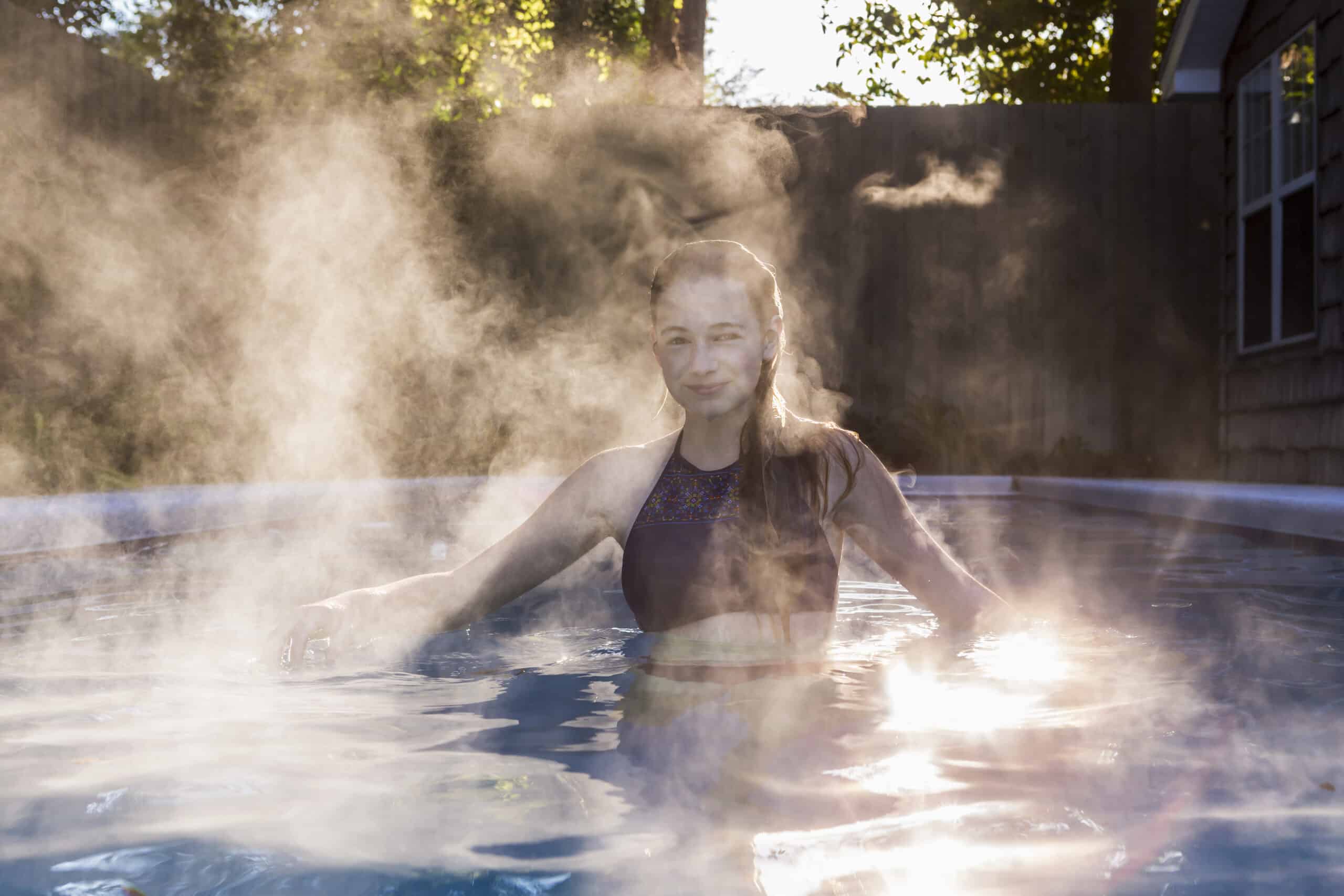Table of Contents - Hot Tub Safety Guide: Essential Tips for Owners
This blog post may contain affiliate links. As an Amazon Associate I earn from qualifying purchases.
Hot Tub Safety Guide: Essential Tips for Owners
Have you ever wondered about the hidden risks lurking in your backyard oasis? We love our hot tubs, but safety should always come first. That’s why we’ve put together this hot tub safety guide to help you enjoy your relaxation time without worry. From temperature control to proper maintenance, we’ll cover all the essential hot tub safety tips you need to know.
In this guide, we’ll dive into the key aspects of hot tub safety. We’ll explore the maximum safe hot tub temperature, share tips to protect children and vulnerable users, and discuss how to maintain a safe environment. We’ll also touch on emergency preparedness and first aid, ensuring you’re ready for any situation. So, let’s get started on making your hot tub experience both enjoyable and secure!
Essential Hot Tub Safety Guidelines
We love our hot tubs, but safety should always be our top priority. Let’s dive into some crucial hot tub safety tips that’ll keep your relaxation time worry-free.
Temperature Control
Have you ever wondered about the perfect hot tub temperature? Well, I once cranked up the heat thinking hotter was better, but boy, was I wrong! The ideal temperature varies from person to person, but here’s a pro tip: start at 98°F or 99°F and gradually increase it until you’re comfortable. Remember, the maximum safe hot tub temperature is 104°F. Anything higher can lead to heat stroke, which is no joke.
Chemical Balance
Now, let’s talk about keeping your hot tub water crystal clear. Proper chemical balance is crucial for several reasons. It ensures water sanitation, maintains pH balance, and keeps the alkalinity in check. Aim for a pH level between 7.2 and 7.8 to prevent skin irritation and equipment damage. Total alkalinity should be between 80 and 120 ppm to keep your pH stable. Trust me, balanced water makes for a much more enjoyable soak!
Electrical Safety
Here’s where things get a bit shocking (pun intended). Electrical safety around hot tubs is no laughing matter. Always hire a licensed electrician for installation and annual inspections. Install Ground Fault Circuit Interrupters (GFCIs) on all electrical circuits near water. These nifty devices cut power when they detect a ground fault, potentially saving lives.
Remember, keep all devices at least 10 feet from the water’s edge unless they’re specifically designed for pool use. And please, no extension cords near the hot tub area – they’re not made for wet environments and can create tripping hazards.
Protecting Children and Vulnerable Users
Let’s talk about keeping our little ones and those with special needs safe in the hot tub. I remember when my niece first visited, and I realized I needed to up my safety game. Here’s what I learned:
Supervision Requirements
We can’t stress this enough: never leave children unsupervised around a hot tub. It’s crucial to have an adult within arm’s reach of young kids at all times. And here’s a pro tip: know where the emergency shut-off switch is located. Trust me, it’s a lifesaver in unexpected situations.
Age Restrictions
The CDC recommends that children under 5 should steer clear of hot tubs. For older kids, we need to take extra precautions. If your child is tall enough to stand with their head above water, they’re good to go. But remember, even for older kids, limit their soak time to 5 minutes if the water’s at 104°F.
Special Considerations for Health Conditions
Hot tubs aren’t for everyone. Pregnant women should avoid them, especially during the first trimester. For those with heart conditions, the heat can cause dizziness, nausea, or even irregular heart rhythms. Some medications can also increase risks, so it’s best to check with a doctor first.
To keep everyone safe, we’ve got a few more tips:
- Lower the temperature to 98-102°F for kids.
- Use jump seats to keep kids partially out of the water.
- Offer plenty of water to prevent dehydration.
- Install childproof fencing and locking covers.
Remember, safety first, fun second. With these precautions in place, we can all enjoy our hot tub worry-free!
Maintaining a Safe Hot Tub Environment
Maintaining a safe hot tub environment is crucial for enjoying those relaxing soaks without worry. I learned this the hard way when I once neglected my hot tub maintenance routine. Trust me, you don’t want to lift that cover and find a green, algae-filled surprise!
Proper Cleaning and Sanitization
Keeping our hot tub clean is the number one rule of maintenance. We need to use either chlorine or bromine to sanitize the water effectively. The CDC recommends maintaining free chlorine levels at a minimum of 3 parts per million (ppm), while bromine should be kept between 3 to 5 ppm, with 5 ppm being ideal.
To keep things fresh, we should shock our hot tub about once a week. But here’s a pro tip: avoid using calcium hypochlorite shock. Instead, opt for a stabilized shock like dichlor, which works better in hot water.
Non-Slip Surfaces
Safety doesn’t stop at clean water. We’ve got to make sure the areas around our hot tub aren’t slippery death traps. Regular cleaning helps prevent the buildup of slime, mold, and mildew that can make surfaces lose traction.
For extra safety, consider using anti-slip solutions. Anti-slip caution tape is great for steps, while anti-slip spray works well on fiberglass and acrylic surfaces. These products provide a textured finish that’s barefoot-friendly and resistant to chemicals.
Secure Cover Usage
A good hot tub cover is like a superhero cape for our spa. It protects against debris, and animals, and even keeps curious kiddos out. To keep our cover in top shape, we should clean it every 1-3 months.
Here’s a tidbit I wish I’d known earlier: avoid using laundry detergents or harsh cleaners on your cover. They can damage the vinyl. Instead, use a cleaner specifically made for hot tub covers.
Emergency Preparedness and First Aid
I’ll never forget the time I hosted a hot tub party, and my friend’s son slipped on the deck. That incident taught me the importance of being prepared for emergencies. Let’s dive into some crucial aspects of hot tub safety that could save a life.
CPR Training
We can’t stress enough how vital CPR training is for hot tub owners. Knowing how to perform CPR could make all the difference in an emergency. It’s not just about being prepared; it’s about having the confidence to act when every second counts.
Emergency Shut-Off Procedures
Here’s a hot tip: always know where your emergency shut-off switch is located. By code, you must have a safety switch within 50 feet and within sight of the spa. For commercial settings like Airbnbs or hotels, an emergency stop function is required in addition to a standard disconnect. It’s a simple precaution that could prevent a disaster.
First Aid Kit Essentials
Let’s talk about stocking your first aid kit. Every public bathing facility must have a standard 16-unit first-aid kit near the spa. Here’s what your kit should include:
- First Aid Book
- Adhesive Bandages
- Tweezers and Scissors
- Compress Bandages
- Triangular Bandage
- Small Ice Pack
- Eye Dressing
- Gauze and Telfa Pads
- Clean Wipes
- CPR Shield
- Latex Gloves
- Emergency Blankets
Remember, being prepared isn’t just about having the right equipment; it’s about knowing how to use it. Stay safe, and enjoy your hot tub responsibly!
Top Safety Tips
| Aspect | Details |
|---|---|
| Maximum Temperature | Max safe temperature: 104°F. Start at 98-99°F and adjust. |
| Ideal pH Level | Ideal pH: 7.2 – 7.8; Total alkalinity: 80-120 ppm. |
| Electrical Safety | Hire licensed electricians, install GFCIs, avoid extension cords near water. |
| Supervision of Children | Always supervise children. Never leave them unattended around hot tubs. |
| Age Restrictions | Children under 5 should avoid hot tubs. Limit soak time for older kids. |
| Special Considerations for Health Conditions | Avoid use during pregnancy and consult a doctor if you have heart conditions. |
| Sanitization Chemicals | Maintain chlorine at 3 ppm, bromine at 3-5 ppm. Use dichlor shock weekly. |
| Non-Slip Surfaces | Use anti-slip solutions on steps and surrounding surfaces to prevent accidents. |
| Emergency Shut-Off Procedures | Know the location of the emergency shut-off switch (within 50 feet and in sight). |
| First Aid Kit Essentials | First aid kit should include bandages, scissors, gloves, compress bandages, CPR shield, etc. |
Conclusion
Hot tub safety is no joke, and it has a significant impact on our enjoyment and well-being. By following these guidelines, we can create a safer environment for everyone to relax and unwind. From keeping an eye on the temperature to maintaining proper chemical balance, every step we take to ensure safety contributes to a worry-free hot tub experience.
I remember the first time I hosted a hot tub party – it was a blast, but it also opened my eyes to the importance of being prepared. To wrap up, let’s not forget that safety is an ongoing process. Regular maintenance, supervision, and awareness are key to creating a secure hot tub environment. By putting these tips into action, we can soak up the benefits of our hot tubs while keeping everyone safe and sound.
FAQs
Q: What steps should be taken to ensure a hot tub is safe?
A: To maintain a safe hot tub, follow these tips: regularly check for any signs of problems, drain and clean the hot tub as recommended, use the correct chemicals for water treatment, choose a suitable model for your needs, implement measures to prevent accidents, ensure children’s safety around the tub, monitor the water temperature closely, and be aware of other potential hazards.
Q: What is the recommended distance between a hot tub and a house?
A: When installing a hot tub, it should ideally be located near an entry door for convenience during colder months. However, ensure it is at least 16 feet away from power lines and 5 feet from any buildings to reduce risks of electrocution and flooding.
Q: What are the safety precautions to keep in mind while using a hot tub?
A: Safety precautions for hot tub use include keeping your head, arms, and upper chest above water to prevent overheating, staying hydrated by drinking water, and avoiding alcohol, which can lead to dehydration.
Q: What are the disadvantages of having a hot tub?
A: Owning a hot tub comes with several cons including high initial costs for installation and maintenance, ongoing expenses for upkeep and operation, significant energy use, increased water consumption, limitations on use depending on the season, and potential health and safety risks. It’s important to work with experts to ensure proper maintenance and safety.



